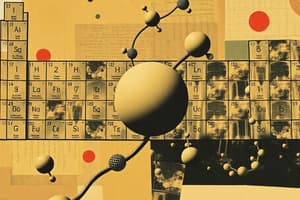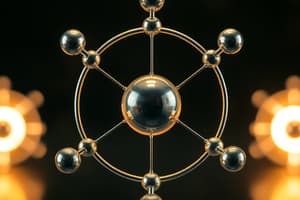Podcast
Questions and Answers
Which statement is true about Dalton's atomic theory?
Which statement is true about Dalton's atomic theory?
- Atoms can be created and destroyed during chemical reactions.
- Atoms can be divided into smaller particles.
- Compounds are formed by the combination of different atoms. (correct)
- All atoms of an element are identical in mass and size.
What was Rutherford's primary contribution to the atomic model?
What was Rutherford's primary contribution to the atomic model?
- Discovered the nucleus and protons. (correct)
- Introduced the electron cloud model.
- Identified neutrons within the nucleus.
- Proposed that atoms are indivisible.
According to Bohr's model, how are electrons organized around the nucleus?
According to Bohr's model, how are electrons organized around the nucleus?
- Electrons occupy the nucleus itself.
- Electrons are found in defined energy levels. (correct)
- Electrons can exist anywhere in the atom.
- Electrons form a single electron cloud.
Which statement best describes Thompson's model of the atom?
Which statement best describes Thompson's model of the atom?
What is the maximum number of electrons that can occupy the third energy level according to Bohr's model?
What is the maximum number of electrons that can occupy the third energy level according to Bohr's model?
Flashcards
Dalton's Atomic Theory
Dalton's Atomic Theory
Atoms cannot be created, destroyed, or divided into smaller particles. They combine to form compounds but remain unchanged during chemical reactions.
Thompson's Model
Thompson's Model
A model of the atom where electrons are embedded in a sphere of positive charge, like raisins in a bun.
Rutherford's Model
Rutherford's Model
Rutherford's model describes the atom as having a dense, positively charged nucleus at the center, surrounded by negatively charged electrons orbiting it.
Bohr's Model
Bohr's Model
Signup and view all the flashcards
Neutrons
Neutrons
Signup and view all the flashcards
Study Notes
Atomic Models
- Different scientists developed models of the atom, including Dalton, Thompson, Rutherford, and Bohr.
- Dalton proposed that atoms are indivisible.
- Thomson's model suggested that atoms have negatively charged particles (electrons) embedded within a positive sphere (like a plum pudding).
- Rutherford's gold foil experiment showed that atoms have a small, dense, positively charged nucleus, with electrons orbiting around it.
- Bohr's model proposed that electrons orbit the nucleus in specific energy levels.
Periodic Table
-
Gold foil Experiment
-
Rutherford used a beam of alpha particles to shoot at a thin gold foil
-
Most particles passed straight through, but some were deflected or bounced back
-
This provided evidence of a dense, positively charged nucleus at the centre of the atom
-
Arrangement of Elements
-
Elements are arranged in rows (periods) and columns (groups) based on their atomic structure and properties.
Atomic Structure & Properties
- Atoms consist of electrons (negative charge), protons (positive charge), and neutrons (no charge).
- The number of protons in an atom determines its atomic number and defines the element.
- Atoms typically have equal numbers of protons and electrons (neutral charge).
- Elements in the same group (column) have similar properties, due to their similar electron configurations.
Studying That Suits You
Use AI to generate personalized quizzes and flashcards to suit your learning preferences.




